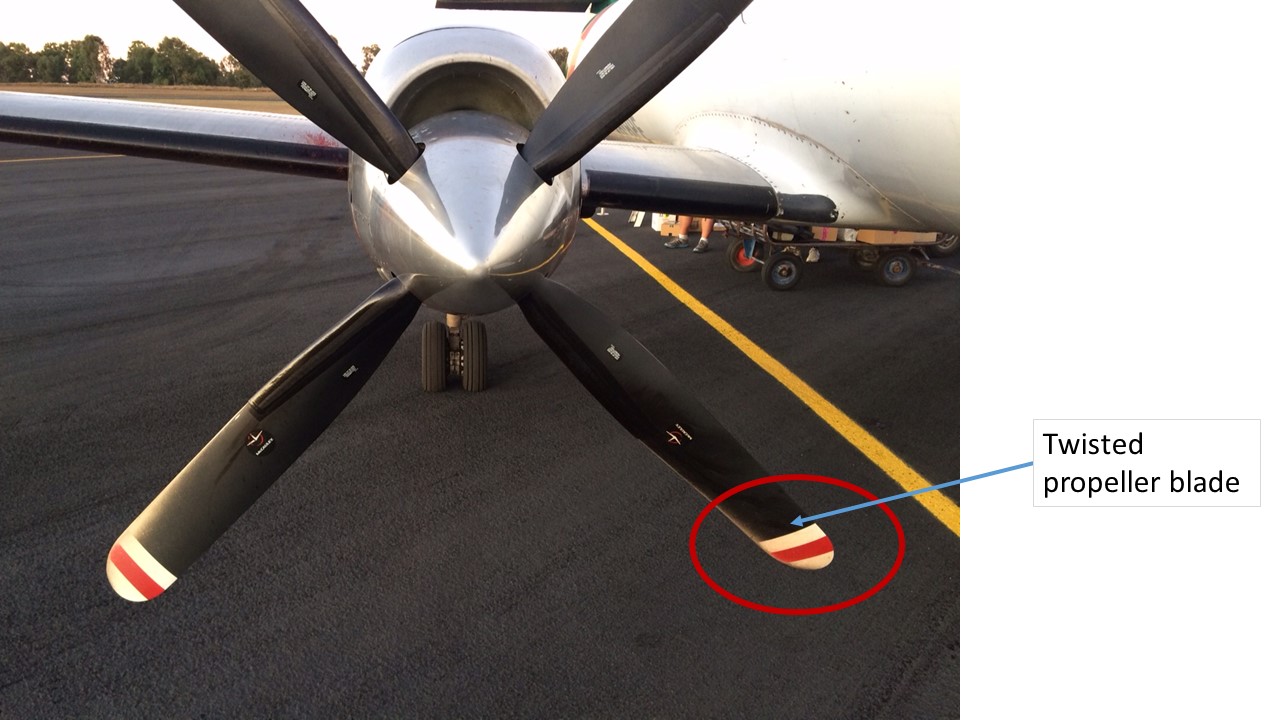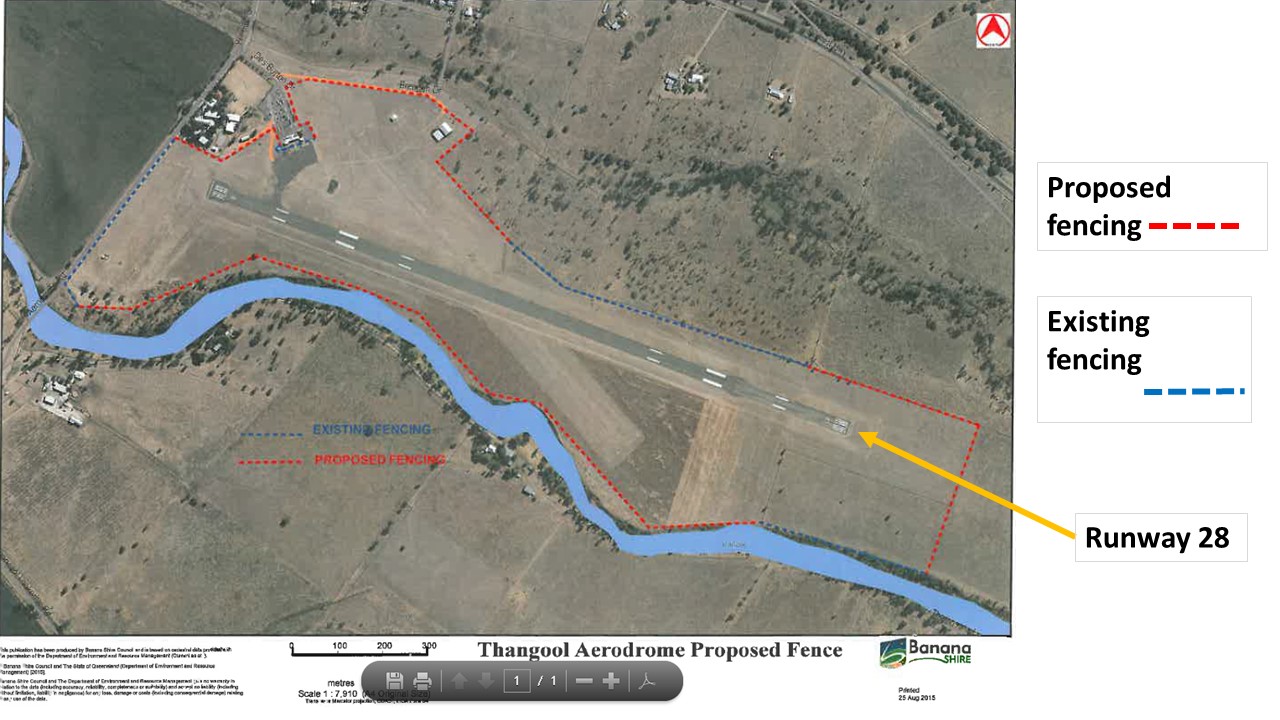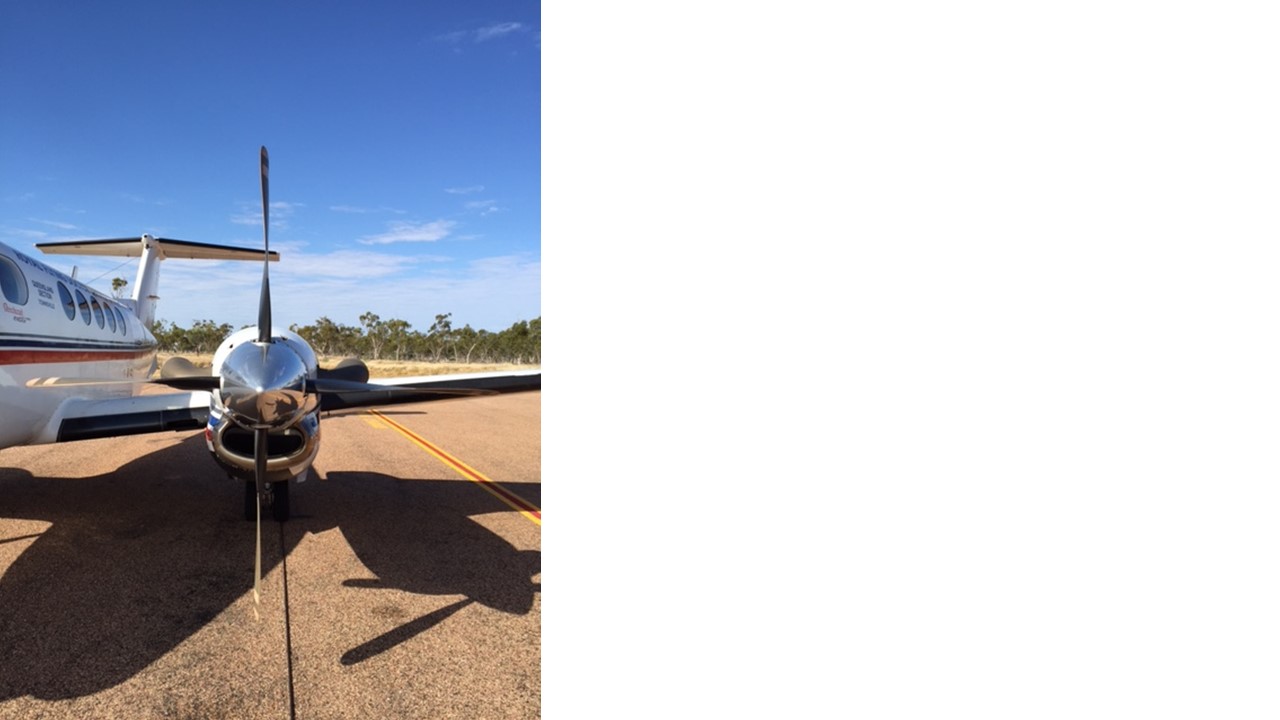What happened
On 1 September 2015, the pilot of a SA227 (Metroliner) aircraft, registered VH-HPE (HPE), was conducting a scheduled freight run from Brisbane, to Emerald, via Thangool Airport, Queensland.
Approaching Thangool, the pilot conducted a Distance Measuring Equipment (DME) arrival with a left circuit onto runway 28, touching down at 0545 Eastern Standard Time, just before first light.
Shortly after touchdown, and with all landing gear wheels in contact with the ground, the pilot saw the glimpse of an animal flash from left to right in front of the aircraft. At the time, the aircraft was travelling at about 80 kt. The right propeller then struck the animal, later identified as a small kangaroo. The pilot reported that following the large bang associated with the propeller striking the animal, there was a lot of vibration throughout the aircraft, but no abnormal engine indications. The pilot continued the landing roll, and used ground idle rather than reverse thrust to slow the aircraft.
The pilot taxied the aircraft to the parking bay, shut down the engines, then carried out an external inspection and found that one of the propeller blades attached to the right engine was twisted (Figure 1). The pilot was not injured.
Following the incident, the operator replaced the right engine and propeller and arranged for the original engine to be further assessed by engineering staff.
Figure 1: Damage to propeller blade on VH-HPE

Source: Pilot
Pilot experience and comments
The pilot held an Airline Transport Pilot Licence (Aeroplane) (ATPLA) and had about 4,900 flying hours, with about 1,310 hours on Metroliner aircraft. The pilot stated that there were no relevant NOTAMS for Thangool Airport, nor any alerting radio calls regarding wildlife. During the approach, the pilot had activated the pilot activated lighting (PAL), which provides runway and airport lighting, however no wildlife was evident on the runway.
Thangool Aerodrome Safety Officer comments
The aerodrome safety officer (ASO) reported that, due to continual pro-active mitigation strategies, such as animal culling, there have been no reported kangaroo strikes at the airport in the last 28 years.
The ASO also commented that they had conducted a runway inspection about 20 minutes prior to the Metroliner landing. No animals were evident during that inspection.
Banana Shire Council comments
Sections of the Thangool Airport had wildlife protective fencing however, it is not fully fenced. At the time of publication, the Banana Shire Council, who own and operate the airport, had a funding application lodged with the Australian Government’s Regional Aviation Access Programme to enable the remainder of the airport fencing to be completed (Figure 2).
Figure 2: Thangool airport with current and proposed fencing marked

Source: Banana Shire Council
Additional wildlife strike
On 2 September 2015, another kangaroo strike was reported to the ATSB (ATSB occurrence number 201503915). In this occurrence, a Raytheon B200 aircraft, VH-FDB, was on a medical retrieval mission from Townsville to Barcaldine Airport, Queensland. As the aircraft touched down in the early hours of the morning, at about 0141 EST the pilot caught a last moment glimpse of the animal before the aircraft struck a small kangaroo. The pilot reported that engine indications were normal, with no noticeable vibration as they completed the landing roll and then shut down the left engine while on the runway. They then taxied clear of the runway using the remaining engine. The strike caused damage to the three propeller blades attached to the left engine and disabled the aircraft (Figure 3)
Operator comment
The operator commented that although the Enroute Supplement Australia (ERSA) entry for Barcaldine Airport warns that both an animal and bird hazard exists, the local base had never sighted any animals, and therefore were somewhat inclined to discount it as a likely occurrence.
The operator/crew had not requested a “roo inspection” prior to the landing. They have also advised the ATSB that apart from the propeller damage, the left engine power module may also need replacing.
Figure 3: VH-FDB showing twisted propeller blades

Source: Operator
Barcaldine Regional Council
A council representative advised the ATSB, that a 6 ft chain mesh fence, with locked gates surrounded Barcaldine Airport. The airport staff conducted regular wildlife inspections at the airport, and also upon request with prior notice. They advised that due to drought conditions, there has been a noticeable increase in kangaroo numbers in the prior months. This increase was due to the animals seeking feed.
Safety action
Whether or not the ATSB identifies safety issues in the course of an investigation, relevant organisations may proactively initiate safety action in order to reduce their safety risk. The ATSB has been advised of the following proactive safety action in response to this occurrence.
Operator of VH-FDB
As a result of this occurrence, the aircraft operator of VH-FDB has advised the ATSB that they are taking the following safety actions:
Strip inspection
The operator is amending their internal procedures, to automatically request a strip inspection for animals at any airport in the ERSA where an animal hazard is listed. This new procedure will also extend to requesting a strip inspection at any aeroplane landing area (ALA) when deemed appropriate.
Safety message
Occurrences involving aircraft striking wildlife, particularly birds, are the most common occurrences reported to the ATSB. They are a significant economic risk for aerodrome and airline operators as well as a potential safety risk. The ATSB regularly publishes a statistical report on the number and frequency of wildlife strikes. The aim of the report is to give information back to pilots, aerodrome and airline operators, regulators, and other aviation industry participants to assist them with managing the risks associated with bird and animal strikes. This is available on the ATSB website.
Both animal strikes and bird strikes remain a mandatory reporting item under the Transport Safety Act 2003. Reporting obligations are available on the ATSB website.
Source: ATSB
Aviation Short Investigations Bulletin - Issue 45
Purpose of safety investigationsThe objective of a safety investigation is to enhance transport safety. This is done through:
It is not a function of the ATSB to apportion blame or provide a means for determining liability. At the same time, an investigation report must include factual material of sufficient weight to support the analysis and findings. At all times the ATSB endeavours to balance the use of material that could imply adverse comment with the need to properly explain what happened, and why, in a fair and unbiased manner. The ATSB does not investigate for the purpose of taking administrative, regulatory or criminal action. TerminologyAn explanation of terminology used in ATSB investigation reports is available here. This includes terms such as occurrence, contributing factor, other factor that increased risk, and safety issue. Publishing informationReleased in accordance with section 25 of the Transport Safety Investigation Act 2003 Published by: Australian Transport Safety Bureau © Commonwealth of Australia 2015
Ownership of intellectual property rights in this publication Unless otherwise noted, copyright (and any other intellectual property rights, if any) in this report publication is owned by the Commonwealth of Australia. Creative Commons licence With the exception of the Coat of Arms, ATSB logo, and photos and graphics in which a third party holds copyright, this publication is licensed under a Creative Commons Attribution 3.0 Australia licence. Creative Commons Attribution 3.0 Australia Licence is a standard form licence agreement that allows you to copy, distribute, transmit and adapt this publication provided that you attribute the work. The ATSB’s preference is that you attribute this publication (and any material sourced from it) using the following wording: Source: Australian Transport Safety Bureau Copyright in material obtained from other agencies, private individuals or organisations, belongs to those agencies, individuals or organisations. Where you wish to use their material, you will need to contact them directly. |



